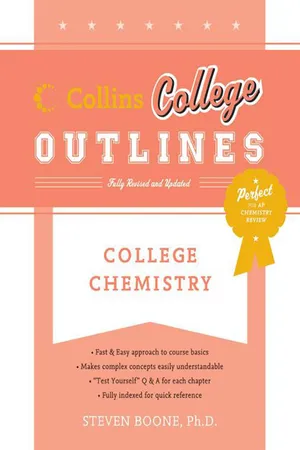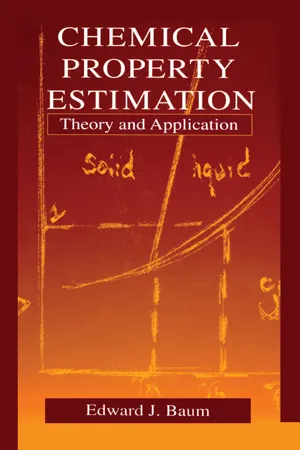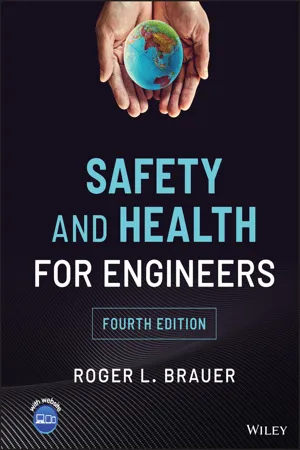Chemistry
Partial Pressure
Partial pressure refers to the pressure exerted by a single gas in a mixture of gases. It is proportional to the fraction of that gas in the mixture and the total pressure. Each gas in the mixture contributes to the total pressure by its partial pressure, which is independent of the presence of other gases.
Written by Perlego with AI-assistance
Related key terms
Related key terms
1 of 4
Related key terms
1 of 3
8 Key excerpts on "Partial Pressure"
- eBook - ePub
- Jeffrey Gaffney, Nancy Marley(Authors)
- 2017(Publication Date)
- Elsevier(Publisher)
composed of a pure gas or a mixture of gases. Example 6.8: Determining the Partial Pressures of Gases in a Mixture A mixture of 10.0 g of oxygen and 5.50 g of methane is placed in a 10.0 L container at 25°C. What is the Partial Pressure of each gas, and what is the total pressure in the container? 1. Determine the Partial Pressure of oxygen. V = 10.0 L, T = 25 + 273 = 298 K n O 2 = 10.0 g 32.0 g / mol = 0.313 mol P O 2 = nRT V = 0.313 mol 0.0821 atm • mol − 1 • K − 1 298 K 10.0 L = 0.766 atm 2. Determine the Partial Pressure of. methane. V = 10.0 L, T = 25 + 273 = 298 K n CH 4 = 5.50 g 16.0 g / mol = 0.344 mol P CH 4 = nRT V = 0.344 mol 0.0821 atm • mol − 1 • K − 1 298 K 10.0 L = 0.842 atm 3. Determine the total pressure. P T = P O 2 + P CH 4 = 0.766 atm + 0.842 atm = 1.61 atm The ratio of the Partial Pressure of one gas in a mixture to the total pressure. gives; P A P T = n A RT / V n T RT / V = n A n T So, the ratio of the Partial Pressure of gas A in a mixture of gases to the total pressure of the mixture is equal to the ratio of the amount of gas A to the total amount of gas in the mixture. This ratio of amounts (n A / n T) is called the mole fraction of gas A in the mixture of gases and is designated by the symbol χ A. This means that the Partial Pressure of a component gas (P A) in a mixture of gases is equal to its mole fraction (χ A) times the total pressure of the mixture (P T). P A = n A n T P T = χ A P T (22) Case Study: Collecting a Gas Sample Over Water A common way to determine the amount of a gas produced by a chemical reaction is to collect the gas over water, as long as the gas is not soluble in the water. The modern apparatus for the collection of a gas over water, shown in Fig. 6.12, is called a eudiometer and is very similar to Stephen Hales’ pneumatic trough. A graduated gas collection tube, sealed at the top, is filled with water and inverted in a reservoir of water - eBook - ePub
Principles of Chemical Engineering Processes
Material and Energy Balances, Second Edition
- Nayef Ghasem, Redhouane Henda(Authors)
- 2014(Publication Date)
- CRC Press(Publisher)
Example 7.12 Molar Composition of Gas PhaseProblemAir and liquid water are at equilibrium in a closed chamber at 75°C and 760 mmHg. Calculate the molar composition of the gas phase The vapor pressure of water at 75°C is.p= 289 mmHg*H 2OSolutionKnown quantities: Air and liquid water are contained at equilibrium in a closed chamber at 75°C and 760 mmHgFind: The molar composition of the gas phaseEXAMPLE FIGURE 7.11.1Cox vapor pressure chart for n-butane. (From Cox, E. R., Ind. Eng. Chem., 15(6), 592, 1923. With permission.)Analysis: Raoult’s law may be applied since the gas and liquid are in equilibrium:y=H 2O=p i *P= 0.38289 mmHg760 mmHgy dry air= 1 −y= 1 − 0.38 = 0.62H 2O7.6 Partial Pressure
Partial Pressure is a way of describing how much of gas is present in a gas mixture. It is defined as the pressure that any one gas would exert on the walls of a container, if it were the only gas present. This relationship is known as Dalton’s law of Partial Pressures.7.6.1 Dalton’s Law of Partial Pressures
Dalton’s law of Partial Pressures states that the total pressure of the mixture is the sum of the Partial Pressures of all the gases present The law of Partial Pressures is expressed as follows:whereP Total=P 1+P 2+P 3+ ⋯PTotal is the total pressure of the mixtureP1 , P2 , P3 , … are the Partial Pressures of the gases present in the mixtureThe Partial Pressure of component A in an ideal gas mixture is given byp A= Py Awhere pAis the Partial Pressure of component A. It is equal to the pressure that would be exerted if A - Louis Theodore, Francesco Ricci(Authors)
- 2011(Publication Date)
- Wiley-AIChE(Publisher)
Partial Pressures . Dalton defined the Partial Pressure of a component as the pressure that would be exerted if the same mass of the component gas occupied the same total volume alone at the same temperature as the mixture. The sum of these Partial Pressures equals the total pressure:(4.28)where P = total pressure, n = number of components, and p i = Partial Pressure of component i .Equation (4.28) is known as Dalton’s law . Applying the ideal gas law to one component (A ) only,(4.29)where n A = number of moles of component A .Eliminating R, T , and V between Equations (4.24) and (4.29) yieldsor(4.30)where y A = mole fraction of component A .ILLUSTRATIVE EXAMPLE 4.10 What is the density of air at 75°F and 14.7 psia? The molecular weight of air is 29.SOLUTION : This example is solved using the ideal gas law:or(4.26)Substituting, ILLUSTRATIVE EXAMPLE 4.11The exhaust gas flow rate from an absorber is 1000 scfm. All of the gas is vented through a small stack that has an inlet area of 1.0 ft2 . The exhaust gas temperature is 300°F. What is the velocity of the gas through the stack inlet in feet per second? Assume standard conditions to be 70°F and 1.0 atm. Neglect the pressure drop across the stack.SOLUTION : Note that since the gas is vented through the stack to the atmosphere, the pressure is 1.0 atm. Calculate the actual flow rate, in acfm, using Charles’ law:(4.27)Substituting Calculate the velocity of the gas: REFERENCES1. R. C. WEAST (ed), “CRC Handbook of Chemistry and Physics ,” 80th edition, CRC Press, Boca Raton, FL, 1999.2. S. MARON and C. PRUTTON, “Principles of Physical Chemistry ,” 4th edition, MacMillan, New York City, NY, 1970.3. R. BIRD, W. STEWART, and E. LIGHTFOOT, “Transport Phenomena ,” 2nd edition, John Wiley & Sons, Hoboken, NJ, 2002.4. L. THEODORE, “Transport Phenomena for Engineers ” International Textbook Co., Scranton, PA, 1970.5. P. ABULENCIA and L. THEODORE, “Fluid Flow for the Practicing Engineer- eBook - ePub
- Irving Granet, Jorge Alvarado, Maurice Bluestein(Authors)
- 2020(Publication Date)
- CRC Press(Publisher)
Dalton’s law (or Dalton’s rule of additive pressures) is found to apply exactly if the ideal gas relation holds for the components and for the mixture. Dalton’s law can be stated as follows:FIGURE 7.1 Dalton’s law.- 1. Each gas behaves as if it alone occupied the volume.
- 2. Each gas behaves as if it exists at the temperature of the mixture and filled the entire volume by itself.
- 3. The pressure of the gas mixture is the sum of the pressures of each of its components when each behaves as described in statements 1 and 2.
Applying Dalton’s law to the situation shown in Figure 7.1 , where the mixture m and each of the components are all shown to occupy equal volumes, yieldsp m=p a+p b+p c(7.1) where p m is the total pressure of the mixture, and p a , p b , and p c represent the pressures that each of the constituent gases would exert if they alone occupied the total volume at the temperature of the mixture. These pressures are called the Partial Pressures of each gas. By assuming that the pressure–volume relationship for an ideal gas is applicable and denoting the molecular weight of the mixture as MWm , we have, in English units, per Section 6.2,p mV =m mR T =m m1545 TMWm(7.2) where m m is the mass of the mixture equal to the sum of the masses of the individual gases. The Partial Pressure of each gas can be substituted for p m , the mass of each gas for m m , and the molecular weight of each gas for MWm in Equation 7.2. This yields a set of ideal gas equations for each component gas. Using each of these equations in Equation 7.1 yields=m mMWm+m aMWa+m bMWbm cMWc(7.2a) Before continuing, it will be convenient to recall certain terms that were discussed briefly in Chapters 1 and 6 . If the molecular weight of a substance is expressed in pounds, the resulting quantity is known as the pound molecular weight, a pound mole, or simply a mole. Thus, 32 lbm of oxygen constitutes 1 lb. mol of oxygen, and 28.02 lbm of nitrogen is 1 lb. mol of nitrogen. It has also been found that 1 mol of a substance, whether it be solid, liquid, or gas, contains the same number of molecules as 1 mol of any other substance. The number of molecules in 1 mol is known as the Avogadro number or Avogadro’s constant (6.02 × 1023 ). Thus, by application of the ideal gas equation of state, it is found that at a given pressure and temperature, 1 mol of gas will occupy a fixed volume, regardless of the gas. This volume is known as the molar volume, and at 14.7 psia and 32°F, it is 358 ft.3 . Table 7.1 - No longer available |Learn more
- Steven Boone, Drew H. Wolfe(Authors)
- 2011(Publication Date)
- Collins Reference(Publisher)
d .d = MMP/RTd = (222 g mol-1 × 755 torr × 1 atm/760 torr)/(0.08206 L atm mol-1 K-1 × 298 K)d = 9.01 g/L6.4 GASEOUS MIXTURESThe ideal gas law equation shows how a single gas behaves under a particular set of conditions. This next section will explore how a mixture of gases behaves under similar conditions. Dalton’s Law of Partial PressuresJohn Dalton was the first scientist to show that the total pressure of a gaseous mixture equals the sum of the Partial Pressures of each gas in the mixture. Today, this statement is called Dalton’s Law of Partial Pressures . A Partial Pressure is the pressure exerted by one gas in a mixture of gases. In an ideal gas mixture, a Partial Pressure is treated like any single-gas pressure in Boyle’s Law, the combined gas law, and the ideal gas law. Mathematically, Dalton’s Law is expressed as follows:P total = P 1 + P 2 + P 3 + … + P n …in which P total is the total pressure and P 1 toExercise 6.18Pnare the Partial Pressures of the n gases in the mixture.People exhale a mixture of N2 (g), O2 (g), CO2 (g), and H2 O(g). If the Partial Pressures of N2 , O2 , and CO2 in exhaled air are 565, 120, and 28 torr, respectively, and the total pressure is 760 torr, what is the Partial Pressure of water vapor, P(H2 O), in exhaled air?Solution 6.18 The total pressure of this gaseous mixture is calculated as follows.P total = P (N2 ) + P (O2 ) + P (CO2 ) + P (H2 O)Therefore, substitute the known values into the equation and solve for the unknown value, P (H2 O).760 torr = 565 torr + 120 torr +28 torr + P(H2 O)P (H2 O) = 760 torr - (565 + 120 + 28) torr = 47 torrPressure-Mole Relationship of Gaseous MixturesThe pressure of a pure gas depends on the moles of gas present. The same is true for a mixture of gases. An increase in the moles of any of the gases in the mixture causes an increase in the total pressure, if the temperature and volume remain constant. This can be expressed as follows: - eBook - ePub
Chemical Property Estimation
Theory and Application
- Edward Baum(Author)
- 2018(Publication Date)
- CRC Press(Publisher)
CHAPTER 6 Vapor Pressure 6.1 INTRODUCTIONThis chapter describes methods of estimating the vapor pressure of a pure chemical and of chemicals in mixtures. The (saturation) vapor pressure, PS (Pa), is the pressure of a pure chemical vapor that is in equilibrium with the pure liquid or solid. It is an important control of a chemical’s partitioning between air, water, and soil and of its volatilization rate. For vapor-solid equilibrium, PS is sometimes called the sublimation pressure. The vapor pressure of a chemical in a mixture of volatile chemicals is its partial vapor pressure.Many different units of pressure are widely used in addition to the pascal, the SI unit. They include the standard atmosphere (1 atm= 101.325 kPa), the bar (1 bar = 100 kPa), the torr (1 atm = 760 torr), and the millimeter of mercury (1 mmHg ≈ 1 torr). The mmHg and the torr are almost exactly equal and can be used interchangeably.The reported saturation vapor pressures of chemicals at ordinary temperatures range from 760 to below 1 × 10−9 torr. Many hazardous chemicals exhibit vapor pressures of less than 1 torr in the normal ambient temperature range of −40 to +40°C. Vapor pressures below 1 torr are difficult to measure, and reliable values are hard to find in the literature. Computational methods that offer reasonably accurate estimates of such low vapor pressures are particularly useful, therefore, and of particular interest to environmental specialists. The subject was reviewed by Burkhard et al. (1985) and Reid et al. (1987). The literature prior to 1981 was reviewed by Mackay et al. (1982) and by Grain (1990a).6.2 A VAPOR PRESSURE MODELSaturation vapor pressure is a sensitive function of molecular structure and ambient temperature. Molecular structure determines the type and strength of the attractive intermolecular forces that a chemical exhibits. The attractive forces are, in order of increasing strength: the London dispersion forces exhibited by all molecules, polar interactions exhibited by all asymmetric molecules, and hydrogen bonding exhibited by molecules containing O–H, N–H, and F–H bonds. The energy required to escape the liquid phase and the vapor pressure depends on the sum of all forces exhibited by a chemical. - eBook - ePub
- Roger L. Brauer(Author)
- 2022(Publication Date)
- Wiley(Publisher)
tot times the percent of the gas in the mixture:(19.1)For example, at sea level the Partial Pressure of oxygen isAt altitudes above sea level, the total pressure is lower than that at sea level. The Partial Pressure of oxygen is also lower. Table 19-1 lists the Partial Pressure of oxygen at various altitudes.Physiology
The Partial Pressure of oxygen affects the ability of the blood to transport oxygen throughout the body. The red cells in the blood perform the transport function. They contain hemoglobin, which forms a loose bond with oxygen. When someone inhales air into the lungs, the red cells pick up oxygen from the lungs and releases it to cells in the body as the blood circulates. During circulation, the hemoglobin also picks up carbon dioxide from the cells. Carbon dioxide is a waste product of cellular metabolism. The red cells return to the lungs, release carbon dioxide, and bond with a new supply of oxygen. The lungs exhale carbon dioxide.The percent of the red cells actively bonding with and transporting oxygen is normally about 97% at sea level. The level of red cell participation is the oxygen saturation level. With increasing altitude and reduced Partial Pressure of oxygen, there is a reduction in the portion of red cells effectively transporting oxygen. This relationship is the oxygen dissociation curve as shown in Figure 19-1 .The effects of oxygen deficiency caused by low‐pressure atmospheres are delayed by increasing the oxygen content of a breathing gas mixture.Figure 19-1.The body has some ability to improve oxygen transport at increased altitude by increasing breathing rate and heart rate. These compensation methods have limitations. The body can also produce higher concentrations of red cells in the blood. However, this change takes nearly a month for full adjustment. Again, this compensating mechanism has limits. People who live at high altitudes have a higher density of red cells in the blood than those who live at sea level. Athletes who must perform at high altitude will often train in such an environment for some time to allow the red cell adjustment to occur. - Michael R. Lindeburg(Author)
- 2014(Publication Date)
- PPI, a Kaplan Company(Publisher)
i (see Eq. 31.9). Similarly, it is possible to convert from mass fraction to mole fraction (see Eq. 31.8).ExampleA gas mixture consisting of 4 moles of N2 , 2.5 moles of CO2 , and an unknown amount of CO is held at two times atmospheric pressure in a container with a volume of 0.13 m3 . The total number of moles in the mixture is 8.5. The temperature of the mixture is 100°C. What is most nearly the mass fraction of CO in the mixture?(A) 0.10(B) 0.20(C) 0.48(D) 0.53Solution Rearrange the equation for total moles in a mixture to find the number of moles of CO in the mixture. Find the mole fraction of each compound in the mixture. Use Eq. 31.7 to find the mass fraction of CO in the mixture. The answer is (B).Equation 31.10 and Eq. 31.11: Partial Pressure and Dalton’s Law31.1031.11DescriptionThe Partial Pressure , p i , of gas component i in a mixture of nonreacting gases i = 1, 2, …, n is the pressure gas i alone would exert in the total volume at the temperature of the mixture (see Eq. 31.10).According to Dalton’s law of Partial Pressures , the total pressure of a gas mixture is the sum of the Partial Pressures (see Eq. 31.11).ExampleThree identical rigid containers each store a separate element. The first container holds helium at 90 kPa, the second container holds neon at 120 kPa, and the third container holds xenon at 150 kPa. The contents of the neon and xenon containers are then pumped into the helium container. After the temperature has stabilized, what is most nearly the pressure of the mixture inside the helium container?(A) 90 kPa(B) 120 kPa(C) 150 kPa(D) 360 kPaSolutionThe Partial Pressure is the pressure a gas would have if it occupied the container by itself. Using Dalton’s law of Partial Pressures, Eq. 31.11, solve for the total pressure of the mixture inside the container.
Index pages curate the most relevant extracts from our library of academic textbooks. They’ve been created using an in-house natural language model (NLM), each adding context and meaning to key research topics.
Explore more topic indexes
Explore more topic indexes
1 of 6
Explore more topic indexes
1 of 4







